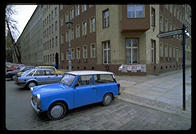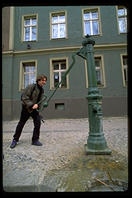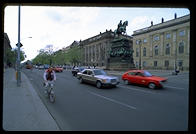
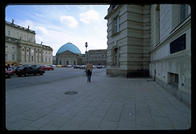
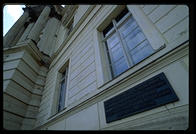
Berlin Aloneby Philip Greenspun |
Home : Travel : Berlin and Prague : Part 1
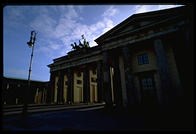 My tale of two cities starts on a rainy day in Berlin, in April 1993,
with my hosts Jean and Carlos, both tireless servants of America's
diplomatic machine. Carlos dropped Jean and me off at the famous
Brandenburg Gate.
Patterned after the entrance to the Acropolis, it was built in 1791 to symbolize peace and a break from the wars of Frederick the Great. Two years later it was crowned by Johann Schadow's Quadriga, four horses drawing the chariot of Nike, goddess of Victory. Its new role as a triumphal arch was to be the more significant one in the years to come. Napoleon marched through into the city in 1806, Kaiser Wilhelm I celebrated German unification here, Nazis marched through when Hitler became Chancellor, and the Red Army hoisted the Soviet flag on top in 1945. The West Germans made a copy of the Quadriga to replace the original one, which had been bombed to pieces. Then the East Germans put the whole Gate behind the Berlin Wall and turned the statue around so it would look better from their side.
My tale of two cities starts on a rainy day in Berlin, in April 1993,
with my hosts Jean and Carlos, both tireless servants of America's
diplomatic machine. Carlos dropped Jean and me off at the famous
Brandenburg Gate.
Patterned after the entrance to the Acropolis, it was built in 1791 to symbolize peace and a break from the wars of Frederick the Great. Two years later it was crowned by Johann Schadow's Quadriga, four horses drawing the chariot of Nike, goddess of Victory. Its new role as a triumphal arch was to be the more significant one in the years to come. Napoleon marched through into the city in 1806, Kaiser Wilhelm I celebrated German unification here, Nazis marched through when Hitler became Chancellor, and the Red Army hoisted the Soviet flag on top in 1945. The West Germans made a copy of the Quadriga to replace the original one, which had been bombed to pieces. Then the East Germans put the whole Gate behind the Berlin Wall and turned the statue around so it would look better from their side.
From the Gate, we walked down the famous Unter den Linden avenue, the flower of Prussian city planning and famous the world over for Nazi troop parades. Jean pointed out the Opernplatz where the Nazis held their first book burning.



No books were in evidence, but we did find hundreds of unsmiling police, dozens of police vans, an armored car and some kind of crane truck. A TV crew explained that an anti-Olympics demonstration was expected. Berlin was jockeying for the 2000 Olympics and I thought that the protesters would recall the unfortunate history of previous German Olympics (Hitler's 1936 showcase of acceptance and the massacre of Jewish athletes in Munich 1972).
As the demonstration rolled by, a young black-clad German woman with flame-dyed hair stood next to me reading a list of complaints by the demonstration's organizers. I asked her to translate and, although speaking English was a struggle for her, she patiently did so. (Germans were remarkably patient with my pathetic language skills and assistance was always easy to find.) Number 1: real estate prices will rise and Berlin will become too expensive for the demonstrators. Number 2: traffic will be snarled. Number 3: elite athletes will be surfeited with money leaving less for common people. Almost all of the complaints were practical ones; nothing was said about the past. What impressed me most about the demonstration was the contrast between the rather small and harmless crowd and the massive police presence. It would take a full-scale riot in the US before you'd see that many police with that much equipment. There were literally hundreds of cops carrying riot shields and wearing all kinds of body armor. They ran alongside the demonstrators while dozens of police vans drove in front of the parade; a helicopter circled overhead. [In September, 1993, the International Olympic Committee voted for Sydney, Australia over Beijing; Berlin had been knocked out in a preliminary ballot.]
The next day I sallied forth fortified with two indispensable books: the Berlin Diaries of Marie Vassiltchikov and the amazing Cadogan Berlin guidebook. Vassiltchikov was a White Russian refugee who worked for the German Foreign Office in Berlin from 1940 onward. Her life at first is a whirl of diplomatic parties and hobnobbing with the vast German nobility. After the heavy bombing of 1943, much of the city's energy is devoted to staying up all night in shelters, clearing rubble during the day, replacing and repairing destroyed essentials, and just getting from one place to another. As enthusiasm for the war dims, some of Vassiltchikov's friends plot to kill Hitler and seize control of the government. As Vassiltchikov relates it, the plotters were yuppies whose primary motivation was to run an independent Germany for themselves and they spent more time planning who would assume what office after Hitler's demise than Hitler's demise itself. Many Germans were executed whose only sin was that they'd been put down on the yuppies' list as a potential deputy assistant foreign minister--they'd never even been consulted about the assassination plan. I was fascinated to see the war from one person's contemporaneous point of view, rather than the standard omniscient omnipresent historian's perspective. The book also piqued my interest in numerous Berlin sites.
The Cadogan guide is a real book; i.e., one could read it from cover to cover and not get bored. Andrew Gumbel writes in the best tradition of British erudition and scholarly tourism. The book starts with broad overviews of politics, art, and architecture. Walking tours with broad themes include the full and oftentimes bizarre history of every little building and bridge.
In conversations with locals about these books, I quickly discovered that both deal with a part of the past that West Berliners would rather forget. Berliners are genuinely confused when you express interest in the Third Reich aspects of their fair city. They believe that Berlin should be toured like Paris, London, or Rome. This would be a great idea if not for the fact that while the Parisians were building Notre Dame, Berlin was a swamp (the name "Berlin" comes from a Slavic word for "bog"). The other cities collected the artistic riches of vast empires for centuries. It was not until the late 18th century that Frederick the Great had made Prussia into a state of any significance. Furthermore, the Prussians spent so much money on wars that precious little was left over to adorn their capital (Hitler, too, had big architectural plans for Berlin that were shelved for WWII). Thus, Berlin never had the artistic treasures of the other capitals.
Berlin's architectural high points are described well by Christopher Isherwood, whose stories were the basis of the musical Cabaret: "[the] self-conscious civic center of buildings round Unter den Linden, carefully arranged. In grand international styles, copies of copies, they assert our dignity as a capital city--a parliament, a couple of museums, a State bank, a cathedral, an opera, a dozen embassies, a triumphal arch; nothing has been forgotten. And they are all so pompous, so very correct ..." Aristophanes's ridiculous city planner (Miton?) would have felt right at home here.
In being an artificially designed imperial capital, Berlin is much like Washington, D.C. Washington, however, was designed by an artistic and original Frenchman whereas Berlin was copied from artistic and original French things. A second difference is that Washington is so far away from Paris, London and Rome that it doesn't suffer by comparison. The final difference is that Washington wasn't visited by the Royal Air Force and the Red Army. (St. Petersburg is another built-from-scratch Baroque capital, but Peter the Great had unfair advantages, e.g. hiring the best artists from all over Europe and giving them 100,000 stonemasons to work to death.)
Even if all the Frederick the Great-era buildings were intact, why would they be interesting to foreign tourists? Frederick mostly conquered little states that nobody has heard of today. Hitler is much more interesting. He conquered big states that are still around, almost conquered even bigger ones, and came close to getting the whole ball of wax. Despite this notoriety, Berliners cannot see the touristic appeal of the Nazis.
This might be because Hitler and Berlin never liked each other. Hitler was Catholic and so were many of his inner circle; Berlin is a Protestant city. Hitler was an Austrian commoner; Berlin was the stomping ground of Prussian aristocracy. Goebbels came here in 1926 to rally Nazi support and described Berlin as a "monster city of stone and asphalt." Berlin consistently voted against the Nazis (Vassiltchikov notes educated Berliners huddled in bomb shelters complaining about the "women of Germany who voted Hitler into power"). Although the regionalism of Germany is difficult for Americans to fully appreciate, try to imagine NY's Ed Koch somehow getting elected Governor of Texas. Texans turn up their noses at first but are elated when Koch rolls over Oklahoma, Louisiana, New Mexico and Kansas. However, as their relatives serving in the Texas Army are cut down by tenacious Minnesotans and their houses are leveled by bombers from California, the honeymoon comes to an end.
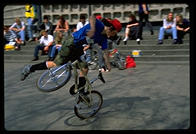 I started my first walking tour at the bombed-by-the-British-in-1943 Kaiser Wilhelm Memorial Church. The American historian Gerhard Masur described this as "one of the few buildings to be improved by the fall of bombs and the ravage of fire." I'm inclined to agree, for the original 1895 structure looked pretty ponderous and the bombs opened it up intriguingly. Today it is a gathering place for punks
and other marginal elements of Berlin society. Southern Germany is almost completely white, working and middle-class and I was a bit surprised to find darker skin, foreign tongues, idleness, and a vaguely threatening atmosphere.
I started my first walking tour at the bombed-by-the-British-in-1943 Kaiser Wilhelm Memorial Church. The American historian Gerhard Masur described this as "one of the few buildings to be improved by the fall of bombs and the ravage of fire." I'm inclined to agree, for the original 1895 structure looked pretty ponderous and the bombs opened it up intriguingly. Today it is a gathering place for punks
and other marginal elements of Berlin society. Southern Germany is almost completely white, working and middle-class and I was a bit surprised to find darker skin, foreign tongues, idleness, and a vaguely threatening atmosphere.
A semisophisticated bum told me in German that he wanted to take a particular bus but didn't have any change. I pleaded ignorance of German and he repeated the complex story in better English than any of the working Germans I'd met! Speaking of English, all Germans are forced to learn it in school and Americans have a strange idea that everyone there speaks English. Well, were you forced to take piano lessons when you were a kid? How well can you play now? Few Germans practice their English after getting out of school. Although Germans watch American movies and TV shows, these are always dubbed except in the very biggest cities. You cannot rent subtitled videos here, only dubbed movies. None of the Germans I know who share a house with a native English speaker take advantage of that person's presence to practice their English. I only met one West German who was drawn to English literature and the culture of English-speaking countries. Christoph, a government worker, was typical: "I only like to practice my English a bit so that I can travel in Asia."
I walked from the Kaiser Wilhelm church up Tauenzientstrasse to the Post Museum. Stamps from the 18th century, stamps from the 19th century, stamps from the 20th century, and ... no stamps from the Nazi period were what I found at the Post Museum. Instead, there was a 16-minute film about Hitler and the Third Reich in Berlin.
Watching a movie in a poorly-understood foreign tongue is a bit like watching TV commercials with the sound off--the real message comes through more clearly because you aren't distracted by commentary. The start was just like American documentaries about Hitler: the Reichstag fire, happy spectators waving Nazi flags at parades down Unter den Linden, the 1936 Olympics. Then the action darkened with a shift to the impressive German armament industry preparing for war. The next big scene is Berlin being bombed by the British. At this point, it occurred to me that here might lurk the German passion for demonstrating against armaments. The German people have suffered during wars that followed great preparations and the stockpiling of arms. Americans, by contrast, have suffered during wars that followed periods of disarmament and lassitude.
After the bombs, the rubble, and dead bodies being carried off, one sees German women working hard in factories and happy Berliners sunning themselves by the waters of the Wannsee (the camera never swung around to the other shore where the Final Solution conference was held). The video ends by showing the Battle of Berlin, in which 50ish housewives with mortars defend the city against the Red Army's howitzers.
I liked the movie because it was so different from all the war documentaries I'd previously seen (mostly American and British). Most movies start by trying to give a balanced view of the war by showing footage from all perspectives; they end up leaving one with no idea how the war might have looked from an individual's perspective. This movie stuck to the war a Berlin civilian might have seen and I began to understand Germany's well-developed culture of victimization. "The Russians oppressed us in the east; the Americans roam around our beloved Vaterland speaking English loudly; the Jews are our misfortune with their Holocaust Memorial in Washington; the Israelis dredge up a few German companies' sales of nuclear and chemical weapons to Arabs anxious to finish the Final Solution; the French build nuclear power plants along our border," etc. This is a confusing culture to foreigners raised on a diet of Mein Kampf, the siege of Leningrad, and Blitzkrieg; it became perfectly comprehensible once I'd seen WWII from the "inside Germany" perspective.
As I walked out, I picked up a brochure on collecting German stamps from 1872 through the present (it is at such times that one is struck by just how young Germany is). Until 1933, the stamps are uninspired derivatives of French Art Nouveau or older styles. The Nazi period brings a flowering of artistry. The first stamp shown commemorates Hitler's electoral victory. Next is a beautiful stern portrait of Hitler canceled with a stamp "Berlin, 20. April 1937, Der Führers Geburtstag" revealing the German passion for birthdays and anniversaries. "4 December 1938 Sudetengau" shows a healthy young Aryan couple armed with a pickax overlooking the pastoral additional Lebensraum of the newly acquired Sudentenland. Austrians are comforted by two men jointly holding a Nazi flag with the border marked "Ein Volk, Ein Reich, Ein Führer." Czechs have their stamps canceled with a swastika plus the words "Wir sind frei!" (we are free).
As the war progresses, the stamps keep pace. Rommel's North Africa campaign is strikingly remembered with a swastika over a palm tree, bordered by an Arabesque. Lots of good stamps show the German army overrunning enemy positions and hurling grenades. My favorite stamp has a picture of Uncle Joe Stalin in the middle flanked by cryptic "1939 Postage" (with a crown) and "1944 Revenue" (with a hammer and sickle). The stamp reads "This War is a Jewish War" in English and there are stars of David and hammers and sickles. As the Red Army closed in, the stamps got a little darker. "Ein Volk Steht Auf" (a people stands up) shows three civilians, a young man, a middle-aged man, and a young woman, aggressively holding rifles and crouched under an eagle's wings.
Like a lot of things in Germany, stamps got boring after the war. Many stamps just have denominations on them, although pictures of people rebuilding and the Dove of Peace make occasional appearances. Recent times bring inoffensive stamps against drug abuse and for sexual equality.
I stopped for lunch at the KaDeWe, which must be the largest department store in the world. It is best known for its massive food hall where you can stock your kitchen or just your stomach. The prices and presentation say Paris, but the taste says Chicago. As I was munching my $15 salad, I was joined by Beatrix, a confidence-inspiring Frankfurt banker. "I work for Germany's central bank because they paid for my education. Although tuition is free, food and housing can cost $10,000/year for six years. Middle-class families can't afford university education anymore."
Beatrix sells government bonds at "Dutch auctions." I told her that this reform was proposed every year for the U.S. by economists but somehow never adopted so that a few investment banks continue to skim billions of dollars from taxpayers. "We can't understand your banking system at all. How could the U.S. Congress have been so stupid as to deregulate savings & loans' investments without changing their deposit insurance system?" I reminded her that these "stupid" Congressmen managed to pocket millions in campaign contributions from S&L executives and get re-elected by the public whom they stuck with the $300 billion bill.
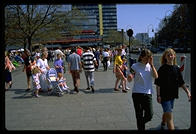 After lunch, I ambled through the Kurfürstendamm, Berlin's most famous shopping street. It is a real let-down after Zurich's Bahnhofstrasse or Madison Avenue, being crammed with jeans shops and Berlin's seedier citizens. The most remarkable sight was the parking style of five cops busy hassling a couple of young Germans. The police had parked their van 50 meters back to avoid a "no standing" zone in a right-turn lane. These aren't your leave-the-squad-car-in-the-middle-of-the-intersection-if-it-is-in-front-of-the-donut-shop-and-fuck-the-public New York or Boston cops.
After lunch, I ambled through the Kurfürstendamm, Berlin's most famous shopping street. It is a real let-down after Zurich's Bahnhofstrasse or Madison Avenue, being crammed with jeans shops and Berlin's seedier citizens. The most remarkable sight was the parking style of five cops busy hassling a couple of young Germans. The police had parked their van 50 meters back to avoid a "no standing" zone in a right-turn lane. These aren't your leave-the-squad-car-in-the-middle-of-the-intersection-if-it-is-in-front-of-the-donut-shop-and-fuck-the-public New York or Boston cops.
Next stop was the Käthe Kollwitz (1867-1945) museum. This woman cornered the market in depressing art. Her big themes were hunger, disease, war, and death, all expressed with moody charcoal drawings and stark woodcuts. Kollwitz's mission was to bring the sorrows of the unfortunate to the attention of the contented and she would return to themes periodically for twenty years or more. One of her big problems was the enthusiasm that young people have for marching off to war and of their leaders for sending them there. Kollwitz depicts mothers trying to keep their children safe from war and Death dragging them off. The saddest drawing for me was one of a woman holding a dead 4-year-old boy. She used her own son Peter as a model for this and 15 years later he was killed in the First World War. The only happy pictures were of mothers with young children; Kollwitz seems to have believed this is the only legitimate and possible kind of happiness. Kollwitz was a bit on the liberal side (say, just to the left of Fidel Castro) and the Nazis booted her from her teaching position at the Academy of Arts in 1933 (she would then have been 66). She died just before the war ended.
My guidebook directed me to the Jewish Community Center, which is built on the foundation of what was once the best synagogue in Berlin. On Reichkristallnacht (November 9, 1938), however, the synagogue was torched and only a few chunks remained for incorporation in the community center. There is allegedly a sculpture out front that attempts to intimidate passersby into tolerance with a quotation from the Old Testament: "Let there be one law for the people and for the foreigners among you." I never got to see it because all hell broke loose on the street with sirens blaring from all directions and dozens of cops rolling up in vans and on motorcycles, snarling and yelling at traffic. My impulse was to hit the deck, but nearby Germans remained standing and were laughing at the police. Eventually a tiny motorcade of International Olympic Committee members cruised by, checking out the city. I suppose the committee learned that Berlin is perfectly safe if one is surrounded by 50 cops.
The final interesting spot on the tour was the Steinplatz, a perfectly symmetrical grassy park. At opposite ends of the park, also in perfect symmetry, are two memorials. One is to the "victims of National Socialism" and the other to the "victims of Stalinism." The first interesting thing about the Nazi monument is that it is built from a chunk of the torched synagogue I'd just been prevented from seeing. The second thing is that it is right next to the offices of Hoechst, once part of the I.G. Farben group, producers of the Zyklon-B gas made famous at Auschwitz. But to me the most interesting thing is the symmetry with the Stalinism monument. This was to be a recurring theme in Berlin: "We aren't like the Nazis and in any case the Nazis were no worse than a lot of other people, e.g. Stalin, the Russians in Eastern Europe, the Jews in Israel, the English in America, etc."
I hopped the S-Bahn mass transit system back to Jean & Carlos's plush embassy digs. The platforms and trains were filled with "no smoking" signs--and people smoking.
